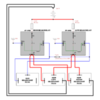So I'm going to start my headlight wiring upgrade and I bought everything I need:
2 - 30 amp Five pin relays so I don't have to wire up a pigtail for the hi/low beam wire
2 - High Heat H4 connectors to replace the lesser quality ones on the car now
1 - Male H4 connector to plug into the existing H4 connector on the car so I don't have to cut up the wiring
Plenty of 14ga red, black, and blue wiring, connectors, and heat shrink tubing
I am attaching the diagram I found and will follow unless someone tells me it is not correct. Since I'm using the 5 pin relays I will have a two pins on each relay to send power out to the right and left headlight. So for my low beam relay there are two pins for sending power out, one for each side. The high beam relay will also have two pins for sending power out to each light also.
With the likely increase in heat from the H4 lamps is there any reason I couldn't/shouldn't drill holes in the back of the fiberglass headlight recess to allow heat to escape?



